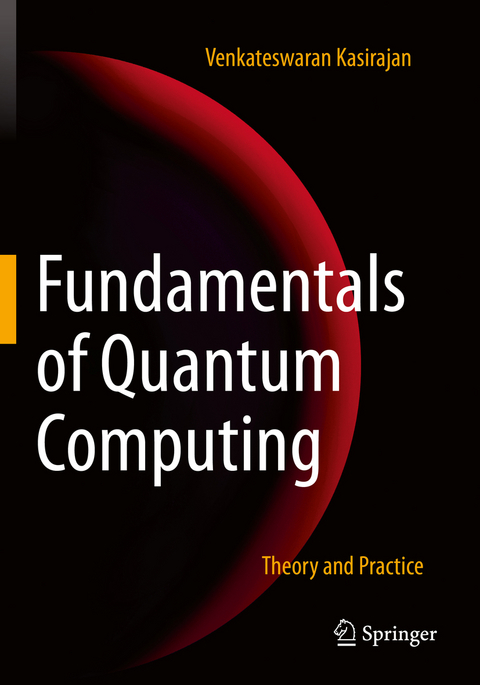
Fundamentals of Quantum Computing
Springer International Publishing (Verlag)
978-3-030-63691-3 (ISBN)
This introductory book on quantum computing includes an emphasis on the development of algorithms. Appropriate for both university students as well as software developers interested in programming a quantum computer, this practical approach to modern quantum computing takes the reader through the required background and up to the latest developments.
Beginning with introductory chapters on the required math and quantum mechanics, Fundamentals of Quantum Computing proceeds to describe four leading qubit modalities and explains the core principles of quantum computing in detail. Providing a step-by-step derivation of math and source code, some of the well-known quantum algorithms are explained in simple ways so the reader can try them either on IBM Q or Microsoft QDK. The book also includes a chapter on adiabatic quantum computing and modern concepts such as topological quantum computing and surface codes.
Features:
o Foundational chapters that build the necessary background on math and quantum mechanics.
o Examples and illustrations throughout provide a practical approach to quantum programming with end-of-chapter exercises.
o Detailed treatment on four leading qubit modalities -- trapped-ion, superconducting transmons, topological qubits, and quantum dots -- teaches how qubits work so that readers can understand how quantum computers work under the hood and devise efficient algorithms and error correction codes. Also introduces protected qubits - 0-pi qubits, fluxon parity protected qubits, and charge-parity protected qubits.
o Principles of quantum computing, such as quantum superposition principle, quantum entanglement, quantum teleportation, no-cloning theorem, quantum parallelism, and quantum interference are explained in detail.
This book includes a section on fault-tolerant quantum computing to make the discussions complete. The topics on Quantum Error Correction, Surface codes such as Toric code and Planar code, and protected qubits help explain how fault tolerance can be built at the system level.
Venkateswaran Kasirajan (Venkat) is an Engineering Director at Trimble, Inc., overseeing a high-profile engineering team. By being a part of two startups, Venkat had the opportunity to work on several core technologies and booted the career of hundreds of engineers. He was also involved in several patents. Before studying computer science and taking up a software engineering career, Venkat studied physics; and currently continues his interest in condensed matter physics. He also researches quantum algorithms and topology, and serves as an internal champion for quantum computing at Trimble Inc. When not working, Venkat is either listening to country music or teaching his daughter while living with his family in Colorado, USA.
PART ONE.- 1 Foundations of Quantum Mechanics.- 2 Dirac's bra-ket notation and Hermitian Operators.- 3 The Quantum Superposition Principle and Bloch Sphere Representation.- PART TWO.- 4 Qubit Modalities.- 5 Quantum Circuits and DiVincenzo Criteria.- 6 Quantum Communications.- 7 Quantum Algorithms.- 8 Adiabatic Optimization and Quantum Annealing.- 9 Quantum Error Correction.- 10 Conclusion.
"The book represents a new and fresh approach to quantum computing, starting with theoretical physical knowledge that is highlighted by beautiful figures. Then, quantum computing is explained by quantum programing languages and extensive languages. It is recommended to everyone interested in quantum computing. It is easy to follow through a beautiful and clear presentation, programming examples and additional exercises." (Andreas Wichert, zbMATH 1477.68005, 2022)
“The book represents a new and fresh approach to quantum computing, starting with theoretical physical knowledge that is highlighted by beautiful figures. Then, quantum computing is explained by quantum programing languages and extensive languages. It is recommended to everyone interested in quantum computing. It is easy to follow through a beautiful and clear presentation, programming examples and additional exercises.” (Andreas Wichert, zbMATH 1477.68005, 2022)
| Erscheinungsdatum | 24.06.2022 |
|---|---|
| Zusatzinfo | XXIX, 463 p. 277 illus., 261 illus. in color. |
| Verlagsort | Cham |
| Sprache | englisch |
| Maße | 178 x 254 mm |
| Gewicht | 935 g |
| Themenwelt | Informatik ► Theorie / Studium ► Algorithmen |
| Naturwissenschaften ► Physik / Astronomie ► Quantenphysik | |
| Schlagworte | Quantum Algorithms • Quantum Communications • Quantum Computing • quantum entanglement • Quantum Information Systems • Quantum supremacy • qubits |
| ISBN-10 | 3-030-63691-7 / 3030636917 |
| ISBN-13 | 978-3-030-63691-3 / 9783030636913 |
| Zustand | Neuware |
| Haben Sie eine Frage zum Produkt? |
aus dem Bereich


